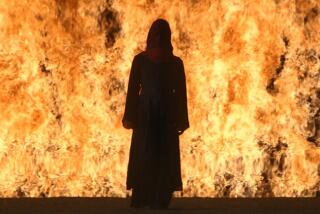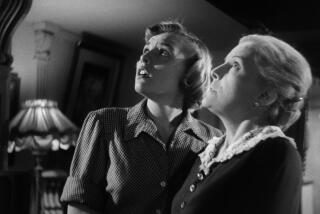Making Sure ‘Vertigo’ Is a Heady Experience
Film buffs may view Tuesday’s video release of “Vertigo” with the same trepidation that James Stewart’s agoraphobic character approached climbing that mission bell tower. Could home video do justice to the painstakingly restored version of Alfred Hitchcock’s 1958 masterpiece that was so rapturously received during its theatrical re-release last fall?
Producer James Katz and his partner, Robert Harris, who both supervised the restoration, won’t keep you in suspense. As good as “Vertigo” looked on the big screen, they say, some shots will look even better on video.
Universal Studios Home Video will release “Vertigo” in a wide-screen edition only (no pan-and-scan) for $19.98. The video will include the original theatrical preview and a 30-minute documentary chronicling the making of the film and the restoration process.
Packaged with the video will be a booklet with facts about the film, Hitchcock, James Stewart, Kim Novak and Bernard Herrmann, who composed the film’s haunting score. It will also detail the preservation efforts that saved the film.
Universal will also release a laserdisc edition on April 22 for $79.98. It will include the documentary, interviews with the film’s creators, a definitive stills file and a never-before-seen extended ending, which Hitchcock was forced to film to satisfy foreign censorship requirements that the film’s killer could not get away with his elaborate scheme.
For those who missed the restored “Vertigo” in theaters, Katz emphasized in an interview that the video release is worlds apart from the video version released in 1984 after the film’s reissue as part of a package of five Hitchcock films that were owned by his estate and had not been seen theatrically for decades.
That release, he said, “was not a restoration. We had barely enough money to get the film out in theaters. It was a patchwork job, but it did so well because people were so starved to see it on the big screen.”
The efforts of Katz, Harris and their crew of technicians have been well-chronicled, and after two years, they might have thought they had seen the last of “Vertigo.” But the video release of the restored edition posed new challenges.
“This was not a video restoration,” Harris said. “It was the transfer of the restored elements to video. You really have to look at it from square one. It’s a totally different entity.”
*
Perhaps the most notable difference from the previous video release is that the film’s devastating ending is literally much darker, as Hitchcock intended. “In the previous video transfers of ‘Vertigo,’ ” Katz said, “the end was very light. We’ve always found that left to their own devices, Telecine operators [who operate the machine that transfers the image] are more oriented to [pictorial] detail than they are to mood.
“The bottom line is that Hitchcock wanted [the ending] dark. All you were supposed to see were Kim Novak’s sparkling diamond earrings, the pendant around her neck, and the collar on Jimmy Stewart’s shirt. Climbing to the top of the tower, you would see moonlight coming through the portals, and then when you got to the top, they would be bathed in moonlight. We’ve done it exactly the way Hitchcock’s notes read during the course of our research.”
Other changes are more subtle. For example, one cutaway to Stewart after he asks Judy/Madeline out on a date, was on film “a really grainy, awful shot,” Harris said. “It is a lot more palatable on video. It’s not great, but it’s a lot less severe. To fix it photochemically on film, it would have made the movie 5% better and would have cost $100,000. To fix it on video, you virtually just push a button.”
Care also had to be taken to preserve the “ethereal quality” of scenes shot with filters, such as Stewart’s rescue of Novak after she leaps into the bay. “The fog filters Hitchcock used bring the audience in and out of reality,” Katz noted. “If you don’t get that across on video, you’re really sort of barreling your way through to something far more specific than you want it to be.”
It took by their count nearly nearly 250 hours to ready “Vertigo” for video “in the way we wanted.”
This, of course, was their mandate. “Universal’s marketing department set it up brilliantly for the video release,” Katz said, “and that’s part of the game as well. They took ‘Vertigo’ and turned an old movie into a new and exciting event. As a result, people who didn’t see it in the theater are aware that the film is something special.
“The studio’s video and laserdisc people wanted something that reflected what we did on the screen. They wanted something extraordinary. Otherwise it would be just another video.”
More to Read
The biggest entertainment stories
Get our big stories about Hollywood, film, television, music, arts, culture and more right in your inbox as soon as they publish.
You may occasionally receive promotional content from the Los Angeles Times.










